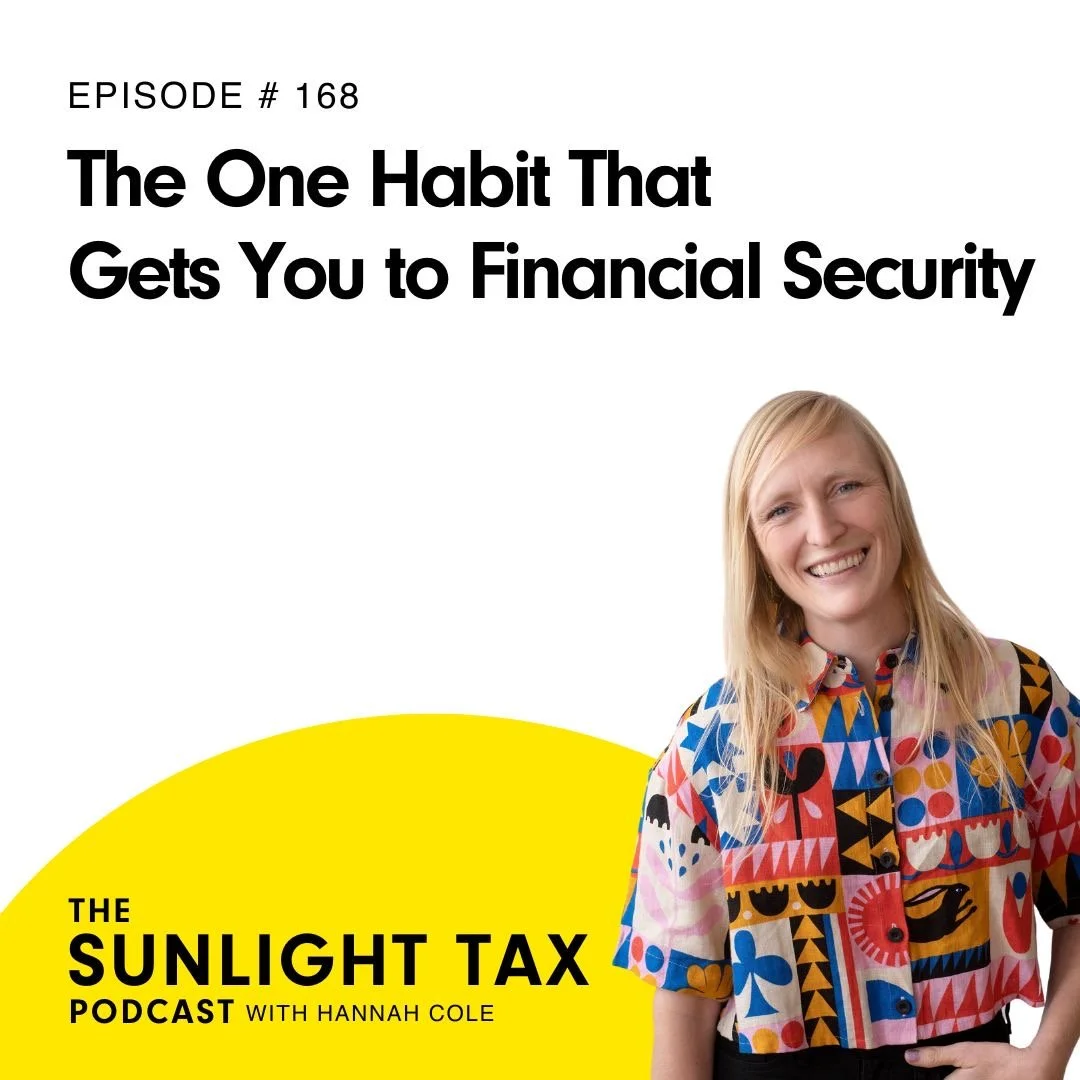
THE SUNLIGHT TAX BLOG:
Tax and Money Education for Creative People, Freelancers and Solopreneurs
search A TOPIC
Categories
- Business Management 17
- Creative Specific 3
- Estimated Quarterly Taxes 5
- General Economy; Tax Policy and Legislation 43
- Get to know Hannah Cole 8
- Interviews and personal stories 27
- Personal Finance 21
- Personal and Career Development 19
- Practical and Tactical Tax 54
- Retirement and Future Success 27
- Sunlight Podcast 149
- Tax Deductions for Freelancers and Self-Employed 8
- the Sunlight Tax Podcast 26
The One Habit That Gets You to Financial Security
Listen and Subscribe Here
In this episode of the Sunlight Tax podcast, I reveal the #1 habit that sets successful freelancers apart: consistent saving. Discover why saving is like a muscle you need to train, how small, steady contributions to retirement accounts can snowball into long-term financial security, and why waiting for the "perfect" moment to save holds you back.
I share my personal journey, real success stories from my community, and practical tips to overcome the psychological barriers that keep many creatives and freelancers from building wealth. Whether you’re just starting out or have been self-employed for years, you’ll learn how to take imperfect but powerful action toward your financial goals and harness the power of compound interest to create a more secure future.
If you’ve ever felt behind on saving, this episode will give you the motivation and strategy you need to start today.
Listen and Subscribe Here
In this episode of the Sunlight Tax podcast, I reveal the #1 habit that sets successful freelancers apart: consistent saving. Discover why saving is like a muscle you need to train, how small, steady contributions to retirement accounts can snowball into long-term financial security, and why waiting for the "perfect" moment to save holds you back.
I share my personal journey, real success stories from my community, and practical tips to overcome the psychological barriers that keep many creatives and freelancers from building wealth. Whether you’re just starting out or have been self-employed for years, you’ll learn how to take imperfect but powerful action toward your financial goals and harness the power of compound interest to create a more secure future.
If you’ve ever felt behind on saving, this episode will give you the motivation and strategy you need to start today.
Also mentioned in this episode:
01:11 The Key Habit of Successful Freelancers
03:40 Overcoming Perfectionism in Saving
06:37 The Power of Consistent Savings
09:12 Building a Safety Net with Small Contributions
11:51 The Psychology of Financial Habits
14:54 Real Success Stories from the Community
18:26 The Importance of Habits Over Windfalls
21:10 Encouragement and Resources for Financial Security
If you enjoyed this episode, please rate, review and share it!
Every review makes a difference by telling Apple or Spotify to show the Sunlight Tax podcast to new audiences.
Links:
Join my free class: Make Taxes Easier and Stash an Extra $152k in Your Savings
Check out my program, Money Bootcamp
Link to pre-order my book, Taxes for Humans: Simplify Your Taxes and Change the World When You’re Self-Employed.
Link to pre-order my workbook, Taxes for Humans: The Workbook
Get your free visual guide to tax deductions
Money Cheat Sheet for the Overwhelmed
LISTEN AND SUBSCRIBE HERE
Money Cheat Sheet for the Overwhelmed
Today, I’m sharing an article I wrote where I give a practical financial overview and is a personal finance cheat sheet for anyone feeling overwhelmed with their finances and taxes.
Listen to this episode to get some finance tips to help you feel more secure as an entrepreneur when it comes to your money.
LISTEN AND SUBSCRIBE HERE
Today, I’m sharing an article I wrote where I give a practical financial overview and is a personal finance cheat sheet for anyone feeling overwhelmed with their finances and taxes.
Listen to this episode to get some finance tips to help you feel more secure as an entrepreneur when it comes to your money.
Also mentioned in today’s episode:
Prioritizing debt repayment 5:52
Why saving for retirement is so important 7:45
Investing for long-term growth 11:23
If you enjoyed this episode, please rate, review and share it!
Links:
https://go.sunlighttax.com/register
Watch Youtube Video Version
Your Complete Guide to the New Student Loan Forgiveness
LISTEN AND SUBSCRIBE HERE
Your Complete Guide to the New Student Loan Forgiveness
In today’s timely bonus episode, I am sharing some information on student loans, the new SAVE program and how this new program can help lower your payments and still lead to student loan forgiveness.
Join me as I give you all the nitty-gritty details about your student loans including who qualifies for the SAVE program and how you can make sure you sign up for it to take advantage.
LISTEN AND SUBSCRIBE HERE
In today’s timely bonus episode, I am sharing some information on student loans, the new SAVE program and how this new program can help lower your payments and still lead to student loan forgiveness.
Join me as I give you all the nitty-gritty details about your student loans including who qualifies for the SAVE program and how you can make sure you sign up for it to take advantage.
Also mentioned in today’s episode:
What’s different about the SAVE program and what does it include? 3:33
Forgiveness of your loan 8:00
Who qualifies for the SAVE program 10:12
What is the Fresh Start program? 18:00
If you enjoyed this episode, please rate, review and share it!
Links:
The Second Best Time is Now
You’re having drinks with a friend after an opening, and the topic turns to money. Life is expensive, the city is expensive, and the distant menace of retirement? Forget it. You turn back to your $14 cocktail and feel depressed.
But wait. Aren’t you the same person who is taking charge of her career? Aren’t you setting new goals, prioritizing your studio time, building your network, learning how to market yourself? You’re smart, and you’re tackling the other hard stuff. So why are you cheating yourself on the bigger picture? You can do this. No need to let the perfect be the enemy of the good here. There is an apt proverb about planting trees: The best time to plant a tree was twenty years ago. The second-best time is now.
Or, investing for retirement, even when you’re not perfect
You’re having drinks with a friend after an opening, and the topic turns to money. Life is expensive, the city is expensive, and the distant menace of retirement? Forget it. You turn back to your $14 cocktail and feel depressed.
But wait. Aren’t you the same person who is taking charge of her career? Aren’t you setting new goals, prioritizing your studio time, building your network, learning how to market yourself? You’re smart, and you’re tackling the other hard stuff. So why are you cheating yourself on the bigger picture? You can do this. No need to let the perfect be the enemy of the good here. There is an apt proverb about planting trees: The best time to plant a tree was twenty years ago. The second-best time is now.
But first, a little digression about beauty. And compound interest.
This is a drawing by Sara Jones. Beautiful, right? It has a lovely feeling of calm about it. Remember this feeling as you read on about saving.
I think saving for the long term can be intimidating, because it seems that we’ll need so much money that we just get overwhelmed. It’s easy to focus on the short term (My rent is so high! Childcare costs are ridiculous! How can I really cut any of my spending? How is $100 a week going to make a dent?). It’s easy to think “I’ll do that later, when I have more money.” But the difference between starting now or ten years from now is bigger than you think.
Now look back at Sara’s drawing. See the curve? That’s the image that should be in your mind as you think about saving. That’s what happens to your money. Why? Because of your friend, Compound Interest.
There’s a lot of great explanation out there about the benefits of compound interest. But if you’re a visual person, like me, it’s really in the picture. So here’s another one, this time with numbers:
This is a chart showing what compound interest does to a one-time $5,000 initial investment. Don’t let the details throw you - the curve is the important part. The light orange part shows the money you put in. The dark orange part is all growth. When you put money in a savings vehicle (like an Individual Retirement Account (IRA), invested in index funds, which have a historic average growth rate of 8% - more on this in a future post), compound interest works to multiply your initial investment over time.
Here’s how it works: Your 5,000 earns 8% interest, so at the end of year 1, you have $5,400. The next year, you make 8% not on 5,000, but on $5,400, yielding $5,842. It doesn’t seem like much yet, but the magic happens near the end. So this little bit of money, after 40 years of compounding, turns into $108,622.61. Now we’re talking.
Now what happens if you make your $5,000 investment an annual habit? Basically, this curve gets steeper. That means you grow real wealth. Check it out:
It’s important to notice the numbers here. The chart reaches into the millions now, not hundreds of thousands. And the light orange part, which represents money you put in, is growing each year, as you make your annual contribution. So in forty years, you now have $1,507,527.81.
Compound interest is your friend. It means you don’t need to save as much as you might fear you do in order to retire.
But what if you wait ten years to start? On the first chart, your $5,000 is worth over $180,000 after 45 years. But after 35 years, ie, ten fewer years of growth, it’s worth about $90,000. That ten years cuts the money in half. Now you see why the first principle of retirement saving is “start early.”
And as a tax professional, I will tell you that your annual contribution limit to a tax-sheltered IRA is even a little higher than in my example. The 2022 limit is $6,000 (and if you’re over 50, it’s $7,000). And you have until April 15, 2023 to contribute for 2022 (yes, it’s retroactive). Opening one is as easy as opening a bank account. I recommend Fidelity or Vanguard.
So don’t let perfection stand in the way of action. Maybe you can’t put aside as much as you’d like, but you can put aside something. But don’t wait for some elusive “better time.” Remember the proverb about the trees? The best time to save was twenty years ago. But the second best time is now.
Disclaimer: True tax advice is a two-way conversation, and your accountant needs to hear your full situation to apply the rules correctly in your case. This post is meant for general information only. Please don’t act on this alone.
The Personal Finance Attitude Adjustment
In my last post, I outlined the basics of a personal finance plan. That article is the “what to do” where I answer questions about insurance, debt management, savings and investments. If you haven’t read it I suggest spending a bit of time with the post because it provides the foundation for getting your proverbial ducks in a row. This week, I’d like to get into the “how to do it” part.
What are your money concerns?
Suggest a blog topic for Hannah here.









